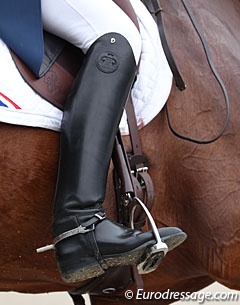
We are often told that our arms must be independent from our body when riding. This means the we have relaxation of the shoulder and elbow and that our arms can move forward and backward while our torso remains upright. Sometimes it’s good to check this. To bend our arms at the elbow and move them forward and back, to make sure they are relaxed and independent. However, something even more difficult and well hidden is the ability to ride with independent legs. This does not mean that they are independent from the body, but that they are independent from each other.
“We must manage, when we use one leg that the other one doesn’t become stuck (against the other side), the leg that is not acting must not move, in short, remains independent of what the other is doing," said Nuno Oliveira.
This seems relatively straight forward and yet it is extremely difficult in practice for a few reasons. Firstly, people overlook what the other leg is doing. Say, for example, you are told to put your leg back and on and you do this. Good right? It’s rare that we then automatically think “and what happened to my right leg when I put my left leg back and on?”
This is exactly what we should be asking, because more often than not even though we got the aid right, we gave a counter aid from the other side, and the horse feels that the left leg is back and on and the right leg is applying pressure and of course he gets confused as to what we are asking.
I see it most particularly in the canter aid. I will tell the student to ask the canter, and they will put their outside leg back and on. They wonder why the horse just goes into a faster trot and continues that way for over half a circle with the rider kicking with the outside leg, wondering why the horse doesn’t understand they want canter. I often tell students to stop and ask exactly the same again but to drop their inside leg down and make sure it’s off the horse and relaxed. And then we have canter. The rider is squeezing the horse with the inside leg at the same time so the horse speeds up and doesn’t understand why the pressure is coming from both sides so responds accordingly…go faster.
 This is a simple example of what then happens in every aid of every exercise. This becomes even more complicated when you need to ask the horse more complex movements; movements that require a specific aid from one leg and another aid from the other. If you are unsure about whether your legs are independent of each other it is good to start at the walk. Ask your horse to step away from your inside leg and ask yourself what your outside leg does unconsciously as you give the aid. Does it draw up, or push against the horse? Or does it remain loose and independent? It’s much harder than you might think and normally this comes down to the fact that many many riders have tight hips. Our bodies are actually not designed to sit on horses and so we tighten the hips as a means of protection and we do so unconsciously.
This is a simple example of what then happens in every aid of every exercise. This becomes even more complicated when you need to ask the horse more complex movements; movements that require a specific aid from one leg and another aid from the other. If you are unsure about whether your legs are independent of each other it is good to start at the walk. Ask your horse to step away from your inside leg and ask yourself what your outside leg does unconsciously as you give the aid. Does it draw up, or push against the horse? Or does it remain loose and independent? It’s much harder than you might think and normally this comes down to the fact that many many riders have tight hips. Our bodies are actually not designed to sit on horses and so we tighten the hips as a means of protection and we do so unconsciously.
In order to loosen your hips on the horse you have to actively think about it. You have to sit in the saddle and think “open up my hip angle, relax my legs.” Once you can do that, and keep it constantly, you can begin to attempt independent leg aids, or a leg aid on one side that makes no difference at all to the position and state of the leg on the other side. You might think it sounds simple and it does, but next time you hop on your horse put your inside leg back a bit and even with just that see what happened to your outside leg…
It might open up a whole new world of understanding as to what else you are telling your horse when you give a simple leg aid.
by Sarah Warne - Photo © Astrid Appels